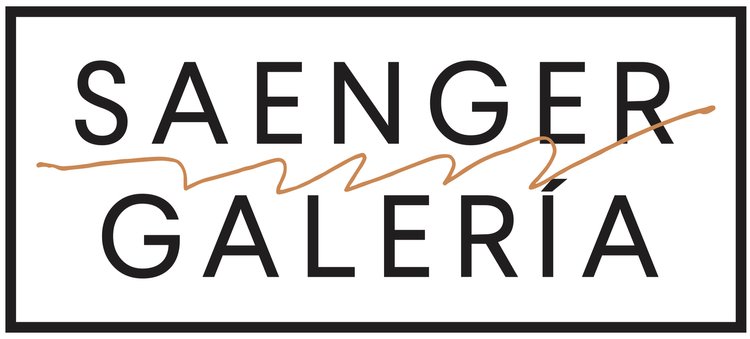Robert Janitz left New York for Mexico City in early 2020, a relocation ventured after a decade in the United States. In shows opened during his New York years—from 2009, when he arrived from Paris—Janitz exhibited a series of series: first, pulled loops in prismatic bands and abstract lines that despite themselves conjured cluttered urban horizons; then came ever more presumptively self-signifying fields constituted by giant vertical strokes that limn the edge of the surface, reiterating the finitude of its physical support. Coincident with the last, Janitz also developed the enduring iconography of an elongated oval stacked atop a sloping mound. Each records the application of paint as congealed process, unfettered in its literalism. (Janitz regularly describes his process as workman-like, with the application of oil paint analogized to spreading grout, or, in a more culinary vein, smearing butter.) Still, these last works especially bait other kinds of readings, not least in their figuring of semiotic becoming: the shapes suggest a human form seen from behind against a monochrome or gradient ground, with the orb standing in for a head and its base then legible as shoulders.
Installation view: Robert Janitz at the Anahuacalli, 2022. Courtesy Museo Diego Rivera Anahuacalli, 2022.
Yet, it somehow took the situation of Diego Rivera’s fantasy temple architecture at the Anahuacalli for Janitz to less equivocally acknowledge this latent referentiality, the product of context but also composition. Robert Janitz at the Anahuacalli followed on the heels of a 2021 site-specific project at Luis Barragán’s Casa Gilardi, which similarly involved a reciprocity of work and setting, if on the grounds of a shared sensibility (evident in calibrations of saturated color, above all). Here, in this pitch-perfect display of over thirty pieces made in Mexico—including four interlocking totems carved out of basalt and quarry stone from the State of Mexico and Michoacán—Janitz installed large-scale paintings on walls, and even the ceiling and floor, to amplify as well as warp Rivera’s near-ubiquitous decorative program. These vignettes were encountered under conditions of dim to incandescent light as one ascended three floors. Across so many spaces, Janitz arranged his work beside Rivera’s and floating buoyant just above it in the case of the tall diptych of entangled tubular units arcing in a duet, Bees of the Future (2022). Elsewhere, he hung single works, pairs, and clusters atop or alongside niches holding some of the 50,000 objects in Rivera’s prized collection: Teotihuacan ceramics, jadeite and alabaster funerary masks, and clay figurines, among so much else.
Installation view: Robert Janitz at the Anahuacalli, 2022. Courtesy Museo Diego Rivera Anahuacalli, 2022.
In this present dialogue between pre-Hispanic and contemporary aesthetics, as the museum frames its mandate more generally, Janitz’s ciphers—the would-be persons, but also the oversized brushstrokes freshly redolent of unreachable hieroglyphs or snakes in terrariums—allow for labile implication. Indeed, in sight of the Xitle volcano and the Izta-Popo mountain range, and inhabiting museum grounds contoured by swollen mounds of once-liquid lava, the maybe-person-paintings also evoked elevations, their “heads” now plumes of smoke emanating from active cones. Writing in the curatorial text accompanying the show, Karla Niño de Rivera invokes Janitz’s new conjoining language of “Volcano Heads”; she likewise genders them in discussing the heads’ coiling strokes-cum-coiffure tresses as evoking “the madness of Medusa, or the hair of the warrior woman Cihuateteo, who was considered an amulet of protection in battle.” This gets at the animism palpable throughout, a vitality that is sometimes pictured as eruption but obtains even in the pulsing heat of chroma. It was hard not to move through these chambers and see these paintings, iterative and long since recursive, utterly anew.
Installation view: Robert Janitz at the Anahuacalli, 2022. Courtesy Museo Diego Rivera Anahuacalli, 2022.
For his part, Janitz discovered in aluminum potted plant sculptures, Fountains of Youth 1-7 (2022), the contour of growing maize, husks extending from the stalk—a departure, despite the continuity of appearance, from the erstwhile allusion to a winter garden. References are perhaps less made than found. (And to be sure, even lava was prepared for by a 2017 show at the Team (Bungalow) in Los Angeles, which Janitz titled Hypothetical Types of Biochemistry, after inorganic particles of cosmic dust that exhibit lifelike behaviors.) Mutability of images and objects alike proved a through-line, with Janitz’s interventions also calling attention to the ways Rivera’s collections (these objects of use) are differently functionalized in the place of exhibition vitrine. Janitz’s sculptures, by contrast, became instruments of another sort: set out on the plaza, at the threshold to the main building’s entrance, El Señorita Volcán (2022), a massive conjunction of a stone base crowned by a volcanic rock carved into a quadripartite geometry, served as a makeshift sundial. For a performance in late August, Janitz invited musicians, including violinist Alexander Bruck, to perform a sonic activation, playing the sculptures. The whole affair proved a profound reminder of incipient possibility, material and otherwise.
Contributor
Suzanne Hudson is an art historian and critic based in Los Angeles. Recent books include Agnes Martin: Night Sea (2017; 2020) and Contemporary Painting (2021).





